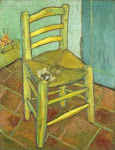
I’ve had occasion this week to think (again) about the nature of Vincent’s illness, the effects on his art and personality, and the popular conception of him today. So much about the historical van Gogh has devolved into cliché. Many think of him as some turpentine-swilling, child-scaring, ear-cutting loony-tune, his paintings the result of a mind gone wild.
WRONG.
Yes, he had a mental illness – I’m one of those who believes he had bipolar disorder, aggravated by absinthe consumption, overwork, and self-denial. Yes, that illness governed the last year and a half of his life, as he was plagued by attack after attack and spent a year in the asylum at Saint-Rémy. Yes, during the most dramatic moment of his illness, he engaged in self-mutilation. But Vincent van Gogh, and van Gogh’s art, should not be defined by that illness.
One need only read his letters to see there was so much more to Vincent than the clichés. Yes, he was stubborn as a mule, yes, he could be temperamental and difficult, but the letters also reveal a man who “felt deeply” (as he put it), someone capable of great tenderness, empathy, and spirituality. Someone fluent in many languages, who read so many books you wonder how he had time to paint, who had such tremendous visual recall that he could remember perfectly a painting by another artist he hadn’t seen for years. Someone who wanted to give love to others, who longed for a wife and family of his own, who saw the humanity in folks marginalized by the world at large. In between the attacks, his letters are lucid and self-aware. And before his first breakdown in December 1888, there are times when he is actually happy. In Arles before Gauguin arrives, for instance: Vincent is so enthused about his new yellow house, so pleased with his work, so optimistic about the future, you’d never guess this was a man who in a few months would cut off a piece of his ear.
In short, he was human. Not a “dangerous beast” (as he put it), not some raving lunatic, not some mad genius. Nor was his art the product of his illness; it resulted from years of study and reflection, from experimentation and innovation. He didn’t slap paint on the canvas in fits of delirium—every brushstroke was carefully chosen, and he knew exactly what he was doing. Even that swirling sky of “Starry Night,” while painted in the asylum (between attacks), says more about his creativity then it does about his illness. (It’s also, by the way, a very atypical painting and one he didn’t care about much.)
I’m tired of the clichés. It’s not fair to him. In life, when his art was beginning to get attention from critics, he worried that people would see his illness instead of his art (he was at Saint-Rémy at the time). Unfortunately, too often that’s exactly what happens.













.jpg)


